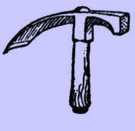


 S Home Glossary U
S Home Glossary U
Revised May 27 2021
A ship is said to be on the starboard or larboard tack, when she is close-hauled, with the wind upon the starboard or larboard side; and in this sense the distance which the sails in that position is considered as the length of the tack; although this is more frequently called a board.
Tack is also applied, by analogy, to that part of any sail to which the tack is usually fastened.
 an adz TFD: An axlike tool with a curved blade at right angles to the handle, used for shaping wood.
an adz TFD: An axlike tool with a curved blade at right angles to the handle, used for shaping wood.
See table at puncheon.
 S Home Glossary U
S Home Glossary U